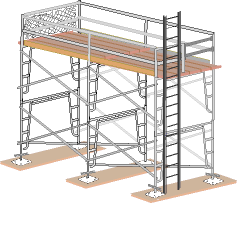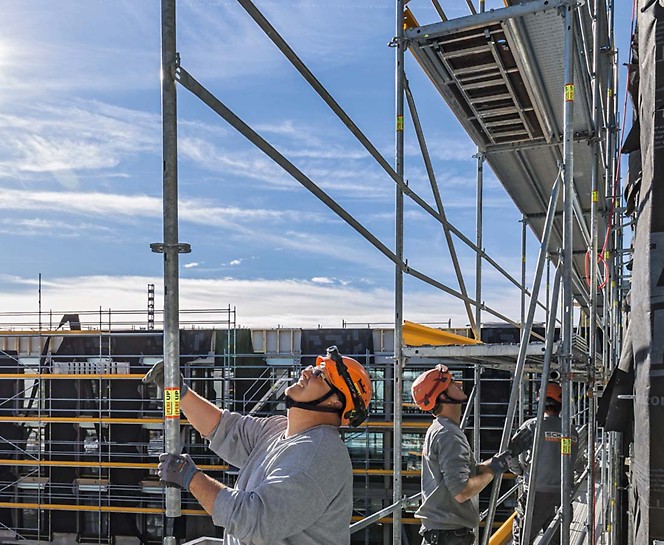High-Quality Residential Scaffolding for Seamless Home Renovations in Surrey
High-Quality Residential Scaffolding for Seamless Home Renovations in Surrey
Blog Article
Discovering the Numerous Types of Scaffolding Made Use Of in Building And Construction Projects
The building and construction market counts heavily on different types of scaffolding to fulfill certain job needs, each offering unique advantages and applications. Conventional framework scaffolding provides a durable structure for general jobs, while put on hold scaffolding is crucial for deal with high-rise frameworks. Various other alternatives, such as system and rolling scaffolding, satisfy effectiveness and wheelchair, respectively. The cantilever variant verifies invaluable in urban environments where area is constrained. Recognizing the subtleties of these scaffolding types is crucial for optimizing safety and security and efficiency on building and construction websites, triggering a closer assessment of their unique attributes and applications.

Typical Frame Scaffolding
Traditional structure scaffolding is among the most extensively used techniques in the building and construction sector due to its effectiveness and convenience. This system contains upright and straight structures that are assembled to create a stable platform for employees and products. The main components consist of vertical blog posts, horizontal journals, and angled dental braces, which together offer a solid framework that can support considerable tons.
One of the vital advantages of conventional structure scaffolding is its versatility to different building jobs, ranging from residential buildings to huge business frameworks. The modular style permits simple assembly and disassembly, making it effective for both long-term and temporary projects. Additionally, the system can be personalized in height and width, fitting various structure designs and site problems.
Safety is vital in scaffolding applications, and typical frame systems are geared up with guardrails and toe boards to stop drops and guarantee worker defense. In addition, regular examinations and adherence to safety and security regulations are crucial in keeping the stability of the scaffold. On the whole, traditional frame scaffolding stays a basic selection in the construction sector, offering a dependable system for labor and boosting general task effectiveness

Suspended Scaffolding
Suspended scaffolding supplies an unique solution for construction tasks that require access to raised surface areas, specifically in circumstances where standard structure scaffolding may be unwise. This kind of scaffolding is typically put on hold from the roofing system or upper levels of a framework, using a system of sheaves, ropes, and platforms to produce a functioning space that can be adapted to different heights.
One of the primary benefits of suspended scaffolding is its adaptability. It can be easily rearranged or lowered to suit adjustments in construction requirements, making it perfect for jobs such as home window installment, façade work, and maintenance on skyscrapers. Additionally, the minimal impact of suspended scaffolding permits much better usage of ground space in metropolitan atmospheres, where space is commonly limited.
Security is an important consideration in the usage of suspended scaffolding. On the whole, put on hold scaffolding supplies a effective and efficient option for accessing hard-to-reach areas in different construction scenarios, enhancing both performance and safety and security on site.
System Scaffolding
System scaffolding, usually considered as a modern-day solution in the scaffolding industry, is composed of pre-engineered elements that can be swiftly set up and adjusted for different building and construction jobs. Scaffolding. This sort of scaffolding is defined by its modular design, which enables for adaptability and efficiency on job sites, suiting different heights and architectural needs
Commonly made from high-strength steel or light weight aluminum, system scaffolding uses boosted resilience and security. The components consist of vertical articles, horizontal journals, and diagonal braces, which interconnect securely, guaranteeing a durable framework. The layout frequently incorporates standardized installations, streamlining assembly and disassembly procedures, therefore decreasing labor time and expenses.

Rolling Scaffolding
Rolling scaffolding is a flexible alternative to traditional set scaffolding, designed for flexibility and convenience of usage on construction websites. This kind of scaffolding consists of a platform supported by structures with wheels, permitting employees to easily relocate it as needed. The movement attribute significantly enhances productivity, as it reduces downtime related to taking apart and assembling dealt with scaffolding.
Generally built from lightweight products such as aluminum or steel, rolling scaffolding supplies a durable yet portable service for projects needing regular repositioning - Scaffolding. It is especially beneficial in tasks such as paint, drywall installation, and electrical job, where accessibility to numerous heights and places is needed
Safety is critical in rolling scaffolding design, with functions such as securing wheels to avoid unintentional movement when in usage, and guardrails to secure workers from drops. In addition, many versions are flexible in height, suiting various job demands.
Cantilever Scaffolding

The style of cantilever scaffolding generally includes utilizing brackets or arms secured to a building or framework, allowing the platform to prolong outward safely. Safety and security is critical; thus, these scaffolds need to be crafted to endure various tons and ecological problems. Regular assessment and maintenance are vital to guarantee structural integrity and worker safety.
Cantilever scaffolding is favored for its flexibility and efficient use room, making it a preferred choice in urban atmospheres where area restrictions are usual. Furthermore, it assists in easier accessibility to high altitudes, inevitably adding to the overall performance of construction projects. As with all scaffolding types, proper training and adherence to safety and security standards are important for employees using cantilever scaffolding.
Final Thought
Typical framework Local scaffolding company scaffolding offers security, while put on hold scaffolding uses flexibility for raised tasks. System scaffolding assists in quick setting up, and rolling scaffolding enhances flexibility for varying work settings.
Traditional structure scaffolding supplies a strong structure for basic tasks, while suspended scaffolding is crucial for job on skyscraper structures.Moving scaffolding is a flexible option to traditional fixed scaffolding, developed for wheelchair and ease of usage on building sites. As with all scaffolding kinds, correct training and adherence to safety standards are important for employees making use of cantilever scaffolding.
Typical frame scaffolding offers security, while suspended scaffolding offers adaptability for raised tasks. System scaffolding facilitates quick assembly, and rolling scaffolding improves wheelchair for varying work settings.
Report this page